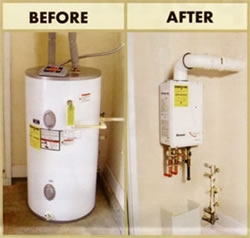Understanding and Fixing Water Heater Leaks from the Bottom
Water heater leaks can be a major concern for homeowners, and leaks originating from the bottom of the unit often indicate serious issues. In this blog, we’ll explore the common causes of water heater leaks from the bottom, provide step-by-step troubleshooting tips, and discuss potential fixes.
Introduction
A leaking water heater can lead to significant water damage and energy inefficiency. Identifying the cause and fixing it promptly is essential to maintain the longevity of your water heater and prevent costly repairs.
Common Causes of Water Heater Leaks from the Bottom
- Drain Valve Issues
- Description: The drain valve is used to empty the tank for maintenance or to replace the water heater. If it becomes loose or faulty, it can leak.
- Signs: Water pooling directly below the valve or dripping from it.
- Fix: Tighten the valve with a wrench. If the valve is damaged, replace it with a new one.
- Sediment Build-Up
- Description: Over time, minerals from hard water settle at the bottom of the tank, creating sediment build-up. This can cause the tank to overheat and crack.
- Signs: Rumbling or popping sounds from the tank, decreased efficiency.
- Fix: Flush the tank regularly to remove sediment. If the tank is damaged, it may need to be replaced.
- Internal Tank Leaks
- Description: Internal leaks can occur due to corrosion inside the tank, often a result of neglected maintenance.
- Signs: Water dripping from the bottom, rust-colored water, reduced hot water supply.
- Fix: Unfortunately, if the internal tank is leaking, replacement of the water heater is usually necessary.
- Faulty Temperature and Pressure Relief (T&P) Valve
- Description: The T&P valve releases water if the pressure or temperature inside the tank gets too high. If it’s faulty or improperly installed, it can cause water heater leaks.
- Signs: Water leaking from the pipe connected to the T&P valve.
- Fix: Test and, if necessary, replace the T&P valve. Ensure it’s installed correctly.
- Loose or Damaged Inlet and Outlet Connections
- Description: The connections where the cold water enters and the hot water exits the tank can become loose or damaged over time.
- Signs: Water pooling around the base, wet connections.
- Fix: Tighten the connections or replace the flex lines if they are damaged.
How to Diagnose the Source of the Leak
- Turn Off the Power
- Electric Water Heater: Switch off the circuit breaker.
- Gas Water Heater: Turn the gas control valve to the “pilot” setting.
- Turn Off the Water Supply
- Locate the cold water shut-off valve above the water heater and turn it clockwise to close it.
- Drain the Tank (If Necessary)
- Attach a hose to the drain valve and direct it to a floor drain or outside. Open the valve and let the water drain out.
- Inspect the Components
- Check the drain valve, T&P valve, and inlet/outlet connections for any visible signs of leakage.
- Look for corrosion or rust around the bottom of the tank, which might indicate an internal leak.
Step-by-Step Fixes
- Tightening Loose Components
- Use a wrench to tighten the drain valve and inlet/outlet connections. Be careful not to over-tighten, which could cause damage.
- Replacing a Faulty Drain Valve
- Drain the tank completely.
- Unscrew the old valve using a pipe wrench.
- Apply plumber’s tape to the threads of the new valve and screw it in place.
- Refill the tank and check for leaks.
- Flushing the Tank to Remove Sediment
- Connect a hose to the drain valve and direct it to a safe location.
- Open the valve and allow the tank to drain.
- Close the drain valve, open the cold water supply, and let the tank refill partially. Drain again to flush out remaining sediment.
- Repeat until the water runs clear.
- Replacing the T&P Valve
- Drain the tank to below the level of the T&P valve.
- Use a wrench to remove the old valve.
- Apply plumber’s tape to the threads of the new valve and screw it in place.
- Refill the tank and test the new valve for proper operation.
- Addressing Internal Tank Leaks
- If you’ve identified an internal leak, it’s time to replace the water heater. Consult a professional plumber to ensure proper installation and disposal of the old unit.
Preventive Maintenance Tips
- Regular Inspections: Check your water heater monthly for any signs of leaks or corrosion.
- Annual Maintenance: Flush the tank yearly to prevent sediment build-up.
- Professional Inspections: Schedule a professional inspection annually to catch potential issues early.

Water heater leaks from the bottom can indicate various issues, from simple fixes like a loose drain valve to more serious problems like an internal tank leak. Regular maintenance and prompt attention to leaks can prolong the life of your water heater and prevent costly damage to your home. If you’re ever in doubt, don’t hesitate to contact a professional plumber for advice and repair services.
Let Us Know!
Experiencing water heater leaks or need a professional inspection? Contact us today to schedule an appointment with our experienced plumbers, there is always a plumber from Handy House heroes in your area. We’re here to help keep your water heater running smoothly and your home safe from water damage.
Also read America’s most trusted Water heater Brands here.

